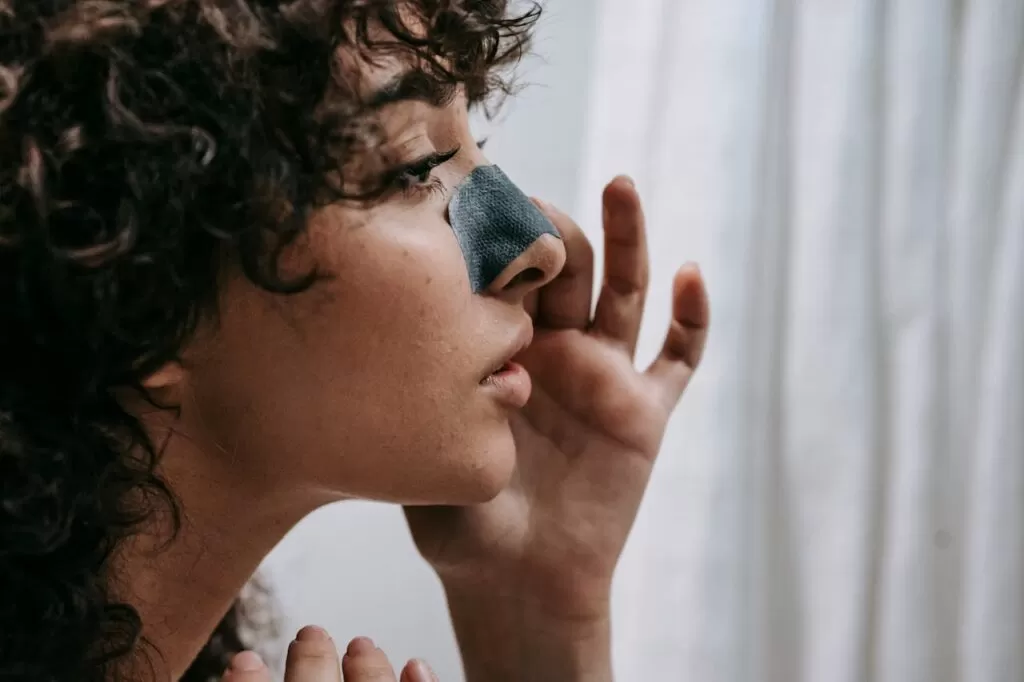This post may contain affiliate links, meaning I may receive a small commission from purchases made through links. Learn more on my private policy page.

Blackheads, those tiny dark spots that often appear on the nose, forehead, and chin, can be a persistent nuisance.
These blemishes occur when hair follicles become clogged with oil and dead skin cells, and exposure to air turns them black. Luckily, you can address blackheads at home with natural remedies and the right products.
This guide will explain practical methods for getting rid of blackheads naturally, other ways to tackle them, and the best products to use.
What is a Blackhead and Where Does It Come From?
A blackhead is a type of acne lesion known as an open comedo. It forms when a hair follicle becomes clogged with oil (sebum) and dead skin cells.
Unlike whiteheads, which are closed off from the air, blackheads are open to the skin’s surface. When the clogged pore is exposed to air, the material inside oxidizes and turns black, giving it a characteristic dark appearance.
Blackheads are most common on the face, especially the nose and chin, but can also occur on the back, chest, neck, and shoulders.
Factors contributing to blackhead formation include excess oil production, buildup of acne-causing bacteria on the skin, hormonal changes, and improper cleansing or skincare routines.
Natural Ways to Get Rid of Blackheads at Home
- Baking Soda Exfoliation: Baking soda is a gentle exfoliant that helps remove dead skin cells and unclog pores. To use it, mix two tablespoons of baking soda with water to form a paste. Apply this paste to your face, focusing on areas with blackheads, and gently massage for a few minutes. Rinse off with warm water. Repeat this process once or twice a week.
- Honey and Cinnamon Mask: Honey has antibacterial properties, while cinnamon improves blood circulation. Together, they can help reduce blackheads. Mix one tablespoon of honey with half a teaspoon of cinnamon powder. Apply the mixture to your blackhead-prone areas and leave it on for 10-15 minutes before rinsing off with warm water. Use this mask once a week.
- Green Tea Scrub: Green tea is rich in antioxidants and helps reduce oil production. Brew a cup of green tea and let it cool. Mix one tablespoon of the tea with a tablespoon of sugar and a teaspoon of lemon juice to create a scrub. Gently massage this mixture onto your face for 2-3 minutes, then rinse with cool water. This can be done once or twice a week.
- Clay Masks: Clay masks, especially those containing bentonite or kaolin clay, are excellent for absorbing excess oil and drawing out impurities from the skin. Apply a clay mask to your face once a week, leave it on for 10-15 minutes, and then rinse off with warm water.
Cetaphil Clay Mask Pro, Dermacontrol Purifying Clay Face Mask with Bentonite Clay is one if the best for a clay mask that has bentonite clay or the Azetc secret- indian healing clay
- Apple Cider Vinegar Toner: Apple cider vinegar has natural astringent properties that can help tighten pores and reduce blackheads. Mix equal parts apple cider vinegar and water, and use a cotton ball to apply the mixture to your face after cleansing. Be sure to follow up with a moisturizer. This might not be the best choice for those with sensitive skin, as it could cause irritation.

Other Ways to Get Rid of Blackheads
- Professional Extractions: Sometimes, home remedies might not be enough, and you may need professional help. Dermatologists and estheticians can perform extractions safely, reducing the risk of scarring and infection.
- Chemical Peels: Chemical peels containing salicylic, glycolic, or lactic acids can help exfoliate the skin and unclog pores. These treatments can be done at a dermatologist’s office or with at-home kits, though professional treatments tend to be more effective.
- Microdermabrasion: This minimally invasive procedure involves using a special instrument to gently exfoliate the skin, removing dead skin cells and unclogging pores. It can improve the appearance of blackheads and overall skin texture.
The Right Products to Use
- Salicylic Acid Cleanser: Salicylic acid is a beta hydroxy acid (BHA) that penetrates deep into the pores to remove excess oil and dead skin cells. Look for a gentle salicylic acid cleanser to use daily. Like the CeraVe SA Cleanser or the La Roche-Posay Effaclar Medicated Gel Cleanser
- Retinoid Creams: Retinoids, derived from vitamin A, help promote cell turnover and prevent the formation of blackheads. Over-the-counter options like adapalene can be effective, but stronger prescription versions may be necessary for severe cases. A great place to start would be with the CeraVe Retinol Serum for Post-Acne Marks and Skin Texture.
Related Reads: How to Use Retinol Creams and Serums for Beginners
- Non-Comedogenic Moisturizers: Keeping your skin moisturized is crucial, but it’s important to use a non-comedogenic (non-pore-clogging) moisturizer. Look for products labeled as oil-free and lightweight.
Related Reads: 11 Best Moisturizers for Oily/ Acne Prone Skin
- Charcoal Masks: Charcoal masks can help draw out impurities from the skin. Use a charcoal mask once a week to help keep your pores clean and minimize the appearance of blackheads.
Conclusion
Blackheads can be stubborn, but with the right approach, you can keep your skin clear and healthy. Incorporating natural remedies into your skincare routine, using effective products, and considering professional treatments when necessary will help you get rid of blackheads and maintain a radiant complexion. Remember, consistency is key, and finding what works best for your skin type will yield the best results.

